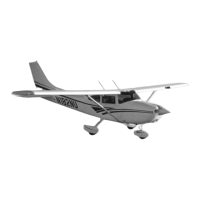CESSNA SECTION 4
MODEL T182T NAV III NORMAL PROCEDURES
GFC 700 AFCS
U.S.
CRUISE (Continued)
For reduced noise levels, it is desirable to select the lowest RPM in the
green arc range for a given percent power that will provide smooth
engine operation. The cowl flaps should be opened, if necessary, to
maintain the cylinder head temperature at approximately two-thirds of
the normal operating range (green band).
CRUISE PERFORMANCE TABLE
CONDITIONS:
Standard Conditions Zero Wind
Figure 4-3
The Cruise Performance charts in Section 5 provide the pilot with
cruise performance at maximum gross weight. When normal cruise is
performed at reduced weights there is an increase in true airspeed.
During normal cruise at power settings between 70% and 88%, the true
airspeed will increase approximately 1 knot for every 150 pounds below
maximum gross weight. During normal cruise at power settings below
70%, the true airspeed will increase approximately 1 knot for every 125
pounds below maximum gross weight.
The fuel injection system employed on this engine is considered to be
non-icing. In the event that unusual conditions cause the intake air filter
to become clogged or iced over, an alternate intake air door opens
automatically for the most efficient use of either normal or alternate air,
depending on the amount of filter blockage. Due to the lower intake
pressure available through the alternate air door or a partially blocked
filter, manifold pressure can decrease from a cruise power setting. This
manifold pressure should be recovered by increasing the throttle
setting or setting a higher RPM as necessary to maintain desired
power.
(Continued Next Page)
ALTITUDE 75% POWER 65% POWER 55% POWER
FEET KTAS NMPG KTAS NMPG KTAS NMPG
5000 139 9.6 130 11.0 120 11.7
10,000 145 10.0 136 11.4 124 12.1
15,000 151 10.4 141 11.9 128 12.4
20,000 158 10.9 147 12.3 132 12.8
T182TPHBUS-00 4-35

